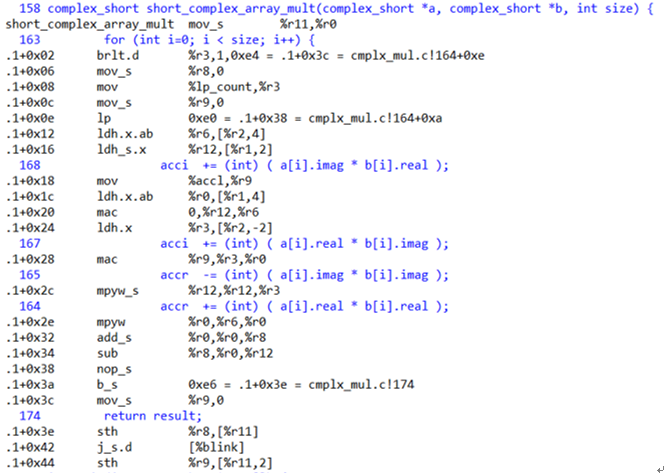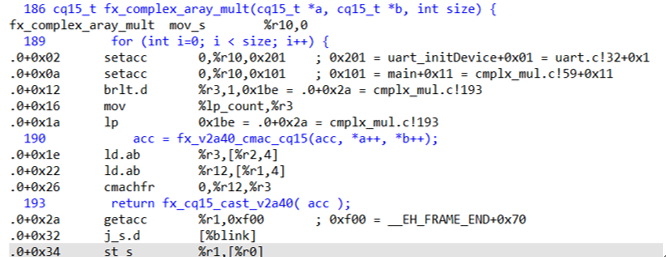ARC DSP: Using FXAPI¶
Purpose¶
- To understand what is ARC Fixed-point API (FXAPI)
- To learn how to use FXAPI to optimize DSP programs
Requirements¶
The following hardware and tools are required:
- PC host
- MetaWare Development Toolkit
- ARC board (EM Starter Kit / IoT Development Kit)
embarc_osp/arc_labs/labs/dsp_lab_fxapi
Content¶
This lab uses complex number multiplication as an example where using just compiler optimization options cannot gain the same effect as calling DSP instructions manually through FXAPI.
Principle¶
In this lab two implementations of complex multiplication are shown with and without FXAPI.
Complex number multiplication¶
Multiplication of two complex numbers
![]() and
and
![]()
Is done using formula:
![]()
In this lab example multiplication and accumulation of two arrays of complex numbers are used as a way to compare performance of ARC DSP extensions when used effectively.
The sum of element wise products of two arrays of complex numbers is calculated according to the following formula:
![]()
where a and b are arrays of N complex numbers.
Implementation without DSP¶
In order to calculate element wise products of two arrays of complex numbers, a struct can be defined that stores real and imaginary parts of the complex number. Therefore, the calculation process receives an array of structures and works on it. The code is shown below:
typedef struct { short real; short imag; } complex_short;
complex_short short_complex_array_mult (complex_short *a, complex_short *b, int size) {
complex_short result = {0,0};
int acci=0;
int accr=0;
for (int i=0; i < size; i++) {
accr += (int) ( a[i].real * b[i].real );
accr -= (int) ( a[i].imag * b[i].imag );
acci += (int) ( a[i].real * b[i].imag );
acci += (int) ( a[i].imag * b[i].real );
}
result.real = (short) accr;
result.imag = (short) acci;
return result;
}
The example keeps real and imaginary values in variables of type “short”, while multiplication results are kept in “int” integer to avoid truncation. Final result is casted to short to return complex number as a result.
Implementation with FXAPI¶
FXAPI makes it possible to directly access complex number instructions (like MAC) available in ARC DSP Extensions. This is done through complex number type cq15_t, and various fx_* functions. Here fx_v2a40_cmac_cq15 FXAPI function is called which performs MAC of two cq15_t complex numbers.
cq15_t fx_complex_array_mult(cq15_t *a, cq15_t *b, int size) {
v2accum40_t acc = { 0, 0 };
for (int i=0; i < size; i++) {
acc = fx_v2a40_cmac_cq15(acc, *a++, *b++);
}
return fx_cq15_cast_v2a40( acc );
}
As with previous implementation q15_t is of similar size as short type, therefore, multiplication result needs larger storage. Here 40b vector accumulator is used directly to store intermediate results of MAC, and is casted to cq15_t on return.
Using IoT Development Kit board for performance comparison¶
To compare performance of these two functions a simple application is created that performs complex array multiplication using either of the implementations above. The program initializes two arrays of complex numbers with random values and calls functions above in a loop (1 000 000-10 000 000 times) to make calculation delay measurable in seconds. This is done eight times, and after each loop a LED on board turns-on. In the result, LED strip on board works as a “progress bar” showing the process of looped multiplications.
The main performance check loop is shown in the following example. The outer loop runs 8 times (number of LEDs on LED strip), the inner loop makes “LOOPS/8” calls to complex multiplication function. LOOPS variable is configurable to change the total delay.
Steps¶
To test the following example, some modification of the code is required to have two loops with and without DSP.
Firstly you must build DSP libraries for this particular configuration of IOTDK:
buildlib my_dsp -tcf=<IOTDK tcf file> -bd ../ -f
IoT Development Kit tcf file can be found in embarc_osp/board/iotdk/configs/10/tcf/arcem9d.tcf
Both examples are to be compiled with DSP extensions.
1. Run program without FXAPI¶
Build with the command:
gmake BOARD=iotdk BD_VER=10 CUR_CORE=arcem9d TOOLCHAIN=mw gui ADT_COPT="-Hdsplib" ADT_LOPT="-Hdsplib -Hlib=../my_dsp"
With high optimization level functions using “short” type is compiled to use DSP MAC operation, enabling significant speedup.

2. Run program with FXAPI¶
Rename main.c.fxapi to main.c, then execute the command:
gmake BOARD=iotdk BD_VER=10 CUR_CORE=arcem9d TOOLCHAIN=mw gui ADT_COPT="-Hdsplib" ADT_LOPT="-Hdsplib -Hlib=../my_dsp"
However, using FXAPI enables compiler to directly use complex MAC instruction “cmachfr”.
